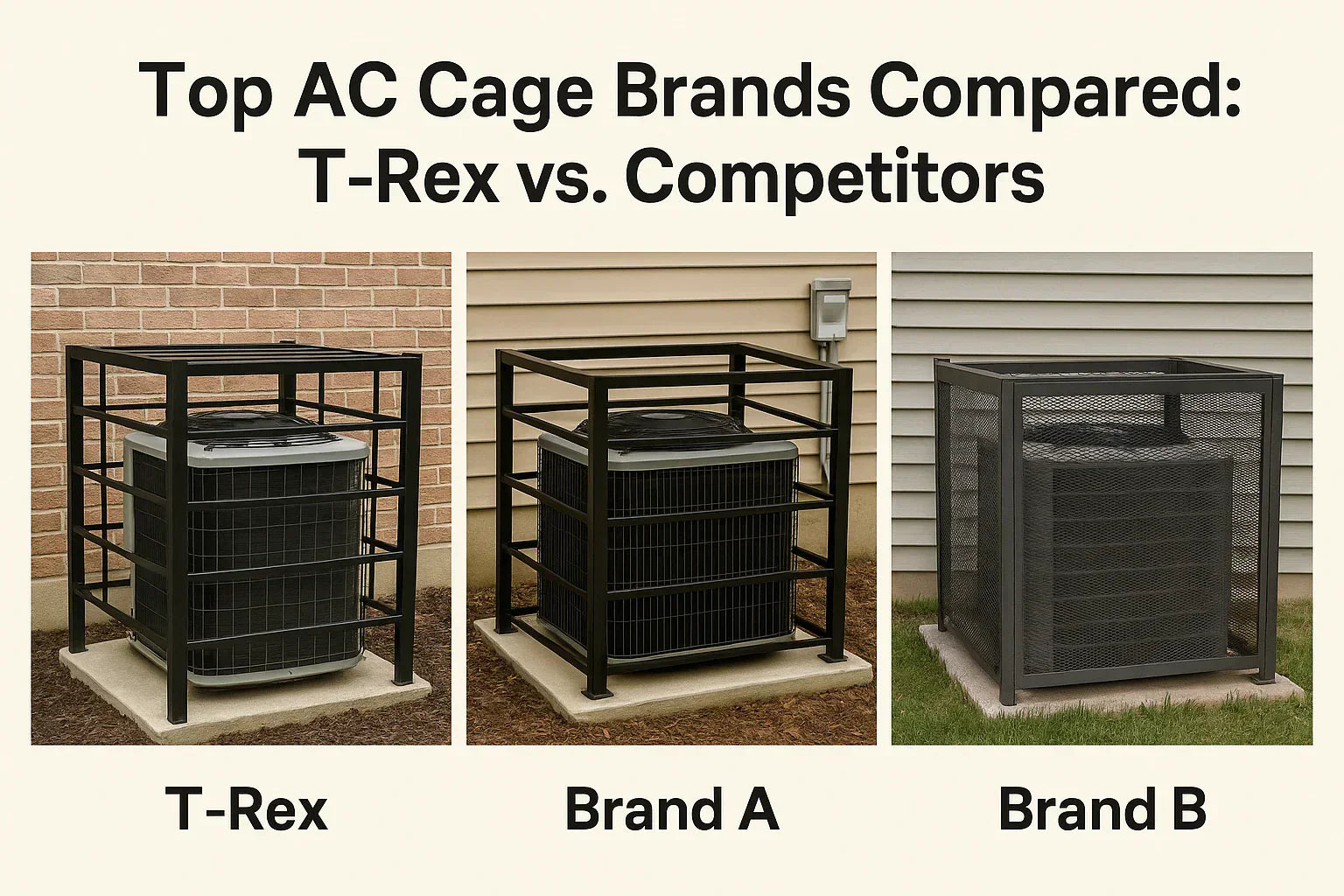🛡️ Why Comparing AC Cage Brands Matters
Choosing the right AC cage for your home isn’t just about theft prevention; it’s about finding a product that balances durability, airflow, ease of maintenance, cost-effectiveness, and real-world protection.
Homeowners like Mike Sanders want peace of mind while ensuring their investment doesn't interfere with HVAC performance or aesthetics. This guide will compare the T-Rex AC Cage with key competitors to help you make an informed decision.
🔍 What to Look for When Comparing AC Cages
Before diving into brand comparisons, evaluate cages based on:
✅ Material Quality: Steel gauge, powder coating, rust resistance.
✅ Airflow Design: Bar spacing and ventilation to maintain system efficiency.
✅ Ease of Installation: DIY-friendly vs. professional requirement.
✅ Security Features: Locking mechanisms, anchor options.
✅ Maintenance Accessibility: Hinged or removable panels.
✅ Price vs. Value: Long-term ROI.
✅ Customer Support and Warranty.
🦖 Brand Spotlight: T-Rex AC Cage
Product Example: T-Rex Air Conditioner Cage Model TREX3X3
✅ Powder-coated heavy-gauge steel for rust resistance.
✅ Adjustable fit for a wide range of condenser sizes.
✅ Wide bar spacing for airflow.
✅ Easy DIY installation with bolt-down anchors.
✅ Hinged panels for maintenance.
✅ Strong visual deterrence.
✅ Competitive price point.
✅ Excellent customer service with clear installation guides.
For performance and airflow protection, see Energy Star’s HVAC airflow guidelines.
🏗️ Competitor 1: CagePro AC Security Cage
✅ Heavy-duty steel build.
✅ Pre-welded frame reduces assembly time.
✅ Powder-coated finish.
✅ Fixed sizing with limited adjustability.
✅ Lockable panels, but limited hinge options.
✅ Higher price point.
✅ Good for professional installation.
Pros: Durable, strong build, pre-welded for easy setup.
Cons: Limited airflow customization, less DIY-friendly.
For airflow and performance impact, see Carrier’s AC installation tips.
🏗️ Competitor 2: AC Guard AC Security Cage
✅ Economical option.
✅ Galvanized steel with powder coating.
✅ Adjustable design with expansion panels.
✅ Lockable top with no hinged sides.
✅ Simple bolt-together assembly.
✅ Lower cost but thinner steel gauge.
Pros: Affordable, adjustable.
Cons: Thinner steel may be less resistant to cutting; no hinged panels make maintenance harder.
🏗️ Competitor 3: Custom Fabricated Cages by Local Welders
✅ Fully customizable to unit dimensions.
✅ Local support and fast lead times.
✅ Variable material quality based on fabricator.
✅ No standardized warranty.
✅ Often heavier, requiring professional installation.
Pros: Perfect fit, strong local support.
Cons: Higher cost, unknown rust-proofing quality, no consistent airflow testing.
See This Old House on outdoor metal maintenance for tips on maintaining custom cages.
⚖️ Side-by-Side Feature Comparison Table
| Feature | T-Rex AC Cage | CagePro | AC Guard | Custom Welded |
|---|---|---|---|---|
| Material | Powder-coated steel | Powder-coated steel | Galvanized steel | Variable |
| Adjustability | Yes | Limited | Yes | Yes |
| Hinged Panels | Yes | Some models | No | Variable |
| Airflow Spacing | Wide | Medium | Wide | Variable |
| DIY Install | Yes | Partial | Yes | No |
| Price | $$ | $$$ | $ | $$$$ |
| Warranty | Yes | Yes | Yes | Varies |
| Visual Deterrence | Strong | Strong | Moderate | Strong |
💸 Price vs. Value Analysis
T-Rex AC Cage
-
Mid-range price, high durability.
-
Easy DIY installation saves on labor.
-
Proven airflow-friendly design.
CagePro
-
Higher price.
-
Durable but less flexible for unit sizes.
-
Better for those who prefer professional installation.
AC Guard
-
Lowest cost.
-
Provides basic theft deterrence.
-
Less durable for high-crime areas.
Custom Welded
-
Highest cost.
-
Tailored fit and maximum strength.
-
Variable airflow and maintenance ease.
🌿 Do AC Cages Impact HVAC Efficiency?
AC cages can reduce airflow if improperly designed, leading to higher energy bills and potential equipment strain. The T-Rex’s wide bar spacing and clearance ensure performance is maintained.
For more on airflow and efficiency, see Energy Star HVAC guidelines.
🔩 Installation Ease and Maintenance
T-Rex: DIY-friendly, detailed instructions, easy maintenance.
CagePro: Easier for pros; may require help for anchoring.
AC Guard: DIY possible; limited maintenance access.
Custom Welded: Requires professional installation.
📈 Real-World Testimonials
Homeowners using the T-Rex cage report:
✅ Zero theft incidents post-installation.
✅ Unaffected system performance.
✅ Straightforward installation.
✅ Peace of mind during vacation and peak seasons.
❓ Frequently Asked Questions
Which cage offers the best balance of cost and performance?
The T-Rex AC Cage is often the best choice for homeowners seeking durability, airflow preservation, and DIY installation.
Will an AC cage affect my system warranty?
No, but check with your HVAC installer for specific conditions.
Can I install the cage myself?
Yes, T-Rex and AC Guard are DIY-friendly.
Will the cage rust?
Powder coating reduces rust risk; regular maintenance helps.
Which is best for high-theft areas?
T-Rex, CagePro, or a custom welded cage with heavy-duty anchors.
🏁 Final Verdict: Which AC Cage Should You Choose?
✅ Choose T-Rex for balanced protection, airflow, cost, and DIY ease.
✅ Choose CagePro if you prefer professional installation and want a heavy-duty, pre-welded design.
✅ Choose AC Guard for a budget-friendly option with basic protection.
✅ Choose Custom Welded for maximum security and a perfect fit, budget permitting.
For practical homeowners like Mike Sanders, the T-Rex AC Cage offers the best blend of security, value, and ease of ownership.







